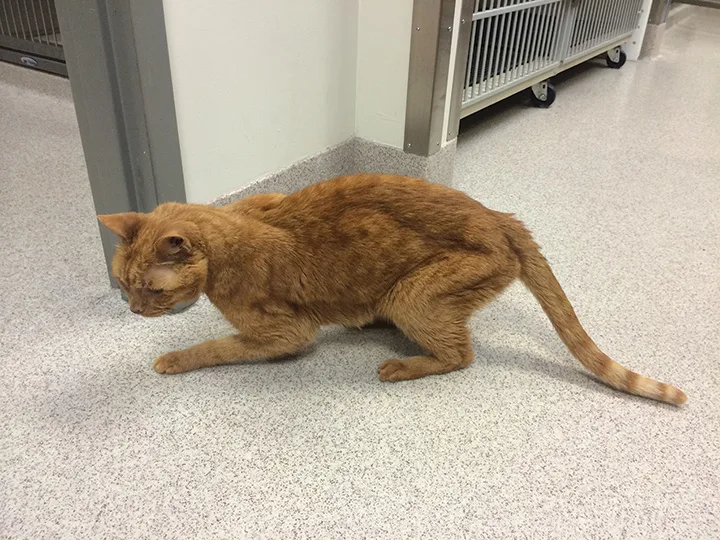Feline Diabetes Red Flags

Your client, Mrs. Murphy, has called the practice, worried because she has needed to empty Snowball’s litter box more frequently and fill his water bowl several times a day. She thinks he has lost weight since his last annual examination (when he had a BCS of 7/9), even though he eats all his food and then begs for more. You check Snowball’s record and note that he is 9 years old. What red flags do you notice?
Several medical conditions (eg, hyperthyroidism) can cause increased water intake and urination (ie, polydipsia, polyuria) and weight loss with increased appetite (ie, polyphagia), but diabetes should be near the top of the rule-out list.
Diabetes at a Glance
Diabetes is one of the 2 most common endocrinopathies in cats, affecting 0.25%–1% of all cats. Feline diabetes is similar to type 2 or noninsulin-dependent diabetes in humans; clinical signs result from insulin resistance and the subsequent failure of pancreatic beta cells to produce enough insulin, leading to high levels of glucose in the blood (ie, hyperglycemia) that cause sugar to “spill” into the urine (ie, glucosuria). Insulin resistance is also believed to cause beta cells to overwork to the point of cell death (ie, apoptosis).
It should be noted that not all cats with hyperglycemia are diabetic. Cats are prone to stress hyperglycemia, particularly during veterinary visits. Episodes of stress hyperglycemia are transient and generally do not result in glucosuria (although it may be present during longer periods of stress); therefore, obtaining urine samples from cats suspected of being diabetic is very important for diagnostic purposes.
In addition to hyperglycemia and glucosuria, the following conditions are typical diabetes red flags and warrant further investigation to rule out the condition:
Corticosteroid administration can suppress insulin secretion in a predisposed cat.
Diabetic peripheral neuropathy, which is demonstrated by approximately 10% of diabetic cats,1 can cause an unwillingness or inability to jump or a plantigrade stance (see Figure).
Middle-aged cats have the highest risk of developing diabetes.
Neutered male cats have been shown to be at increased risk.
Obesity is one of the top risk factors. Excess calorie intake (particularly high levels of dietary fat or carbohydrates) and a sedentary lifestyle lead to increased fat stores, which increase insulin resistance.
Poor oral health or a urinary tract infection may cause a susceptible cat to become diabetic, because insulin resistance can occur from established inflammatory or infectious processes.

Figure. A cat in a plantigrade stance of the pelvic and thoracic limbs; both the hocks and elbows are bearing weight.
Investigation
Diagnostic tests should include a complete blood count, chemistries, urinalysis with culture, and thyroid testing to rule out other diseases and identify concurrent disease processes that may complicate diabetes management. Serum fructosamine should also be evaluated to differentiate between short-term stress hyperglycemia versus long-term problems with glucose regulation.
Related Article: Improving Feline Veterinary Experiences
Treatment
The goal of feline diabetes treatment is remission, which may be possible with prompt initiation of insulin therapy, regular exercise, diligent and frequent blood glucose monitoring, and a low-carbohydrate, high-protein diet. Client vigilance for signs of relapse is key.
|
Diabetes mellitus in cats. Rand JS, Marshall RD. Vet Clin North Am Small Anim Pract 35:211-224, 2005.
Disorders of the endocrine pancreas. Nelson RW. In Nelson RW, Couto GC: Small Animal Internal Medicine, 4th ed—St. Louis: Mosby Elsevier, 2009, pp. 785-796.
Endocrinology. Kipperman B, Rogers B. In Merrill L (ed): Small Animal Internal Medicine for Veterinary Technicians and Nurses—Ames, Iowa, Wiley-Blackwell, 2012, pp 31-37.
Feline diabetes mellitus. Rand, J. In Mooney CT, Peterson ME (eds): BSAVA Manual of Canine and Feline Endocrinology, 4th ed—Gloucester: British Small Animal Veterinary Association, 2012, pp 133-147.
Feline diabetes mellitus. Reusch C. In Ettinger SJ, Feldman EC (eds): Textbook of Veterinary Internal Medicine, 7th ed—St. Louis: Saunders Elsevier, 2010, pp 1796-1816.
Insulin resistance in cats. Scott-Moncrieff JC. Vet Clin North Am Small Anim Pract 40:241-257, 2010.
|
Editor’s note: Liz Hughston is a senior emergency/ICU technician at Adobe Animal Hospital, where she nurses critically ill and emergent patients. Her special interests include endocrinopathies, particularly the treatment and care of diabetic patients.